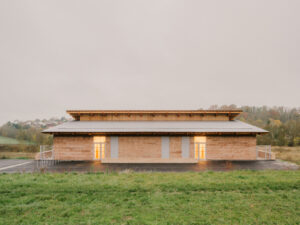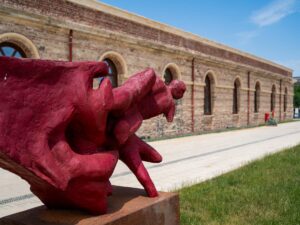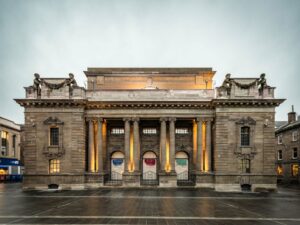- 15 Aralık 2016
- 3085 defa okundu.
4. Kategori Jüri Özel Ödülü, MimED 2016 Öğrenci Proje Yarışması
Antalya:The Textile City
Proje, Antalya Dokuma Fabrikası ve Antalya şehri içinde, kent insanı ve mülteciler için bir program yazmayı ve kent ölçeğinde önermeler yapmayı amaçlar. Ölçekler arası ‘zoom in’ ve ‘zoom out’ operasyonlarıyla tasarım sürecinin kendisini tasarlamaya çalışır. Analiz fazı, bir ‘zoom in’ olarak gelişir. Aynı şekilde, zoom out ile öğrenilen, sentezler ortaya çıkarır. Tasarım süreci şehir ölçeğinde tanımlamalar yapılması ile başlar. Antalya kenti örülmüş bir dokuma olarak tanımlanır. Diğer tanım ise bu örüntüdeki ‘yırtık’lardır. Kentin örüntüsünün yırtıkları, mevcut belleğin söküldüğü bölgeler veya yapılar olarak tanımlanır. Fabrika arazisini çevreleyen dokusal kontrast ,sistemin ve kaosun beraberliğine dikkat çeker. Dokuma Fabrikası ise zoom in deki mimari ölçektir. sistematik ve antisistematik bir örtüşme yaratarak, kendi düzenliliğine bir bakıma ‘başkaldırdığını’ söylenebilir. Dokuma makinesi, zoom-in analizin doruk noktasıdır. Bu noktada, makineden kent ölçeğine yapılan büyük bir zoom out, makinanın mekanizmasını kullanarak yeni bir kentsel dokuma ve fonksiyonları ören bir mimari analojiyi sentezler. Dokuma makinası hem fiziksel eylemdir hem de bir metafor. Bazı önemli yerler, işlevleri ve dokuları ile ana dokuma mekanizmalarını oluşturur. Eğitim, yeşil ve kültürel bellek kimliklerinin izleri farklı ipliklerden oluşan yeni bir örüntü tanımlar. Bir metafor olarak, dokuma mekanizması iki katmanlı bir programı doğurur. İlk katman, ‘omurga’ pragmatik fonksiyonları ve ikinci katman, ‘ruh’ spiritüel fonksiyonlarını içerir. İplikler şehirde fonksiyonel kuşatmalar yapıp gerçek kent fonksiyonlarının izlerini takip ederek yırtıkları örerler. ‘Ipliklerin’ mimari karşılığı dokuma ve yırtıklara referansla mekan tanımlayan ‘kentsel platformlar’dır.
—
The project tries to explore the process of design through ‘zoom in’ and ‘zoom out’ operations. The analysis of the city Antalya, develops as a ‘zoom in’ which involves different scales of existing mechanisms. Likewise, the synthesis & the proposal emerges from a ‘zoom out’ in which what is learned from analysis creates an urban scenario.
The first step of the zooming in is the ‘city’ itself. The design process starts with a formation of an urban vocabulary in the city scale. Antalya is a city with a lot of textures. So the city is defined as ‘a woven fabric’. . The other definition is the term ‘rupture’. It stands for an urban term for the ‘woven fabric’, the city. The ‘ruptures of the city’ can be defined as the zones or buildings where the existing social, architectural and cultural memory is ripped off. Having analyzed the previous urban relations in the city, it can be said that being a ‘rupture’ is actually a time-based process. In the second step of the zoom in, which is the focus area, the textural contrast can be readable in both of the architectural and urban perspectives. The different textures surrounding the site create a togetherness of system& chaos. The Dokuma Factory is the another scale of the zoom in. The way the factory’s getting old with all its rust, dust and colors , gives clues of the memory & revolt . The identity of the factory has started to revolt its regularity, creating an overlap of systematic&antisystematic.
The last section of the zoom in is ‘the loom’, the weaving machine. The mechanical presence of it in the Dokuma Factory, is the climax point of the analysis zoom-in. At this point, a huge zoom out from the structure of the machine to the city scale, offers a synthesis of an analogy, which suggests using the mechanism of the loom in order to create urban texture with an architecture that weave and overlap the functions spatially.
The loom is both a physical act and a metaphor. The city has some main looms with their functions and textures, such as the Vakıf Çiftliği, the University and the Dokuma Factory. Within their identities of education, green and cultural memory, they act as architectural looms, defining a start point for the future urbanism of the city.
The marks of the identities define a new woven fabric composed of different yarns. As a metaphor, the loom mechanism gives reference to a two-layered program. The answer of the question ‘What was ripped off?’ for the refugees and the natives gives the program. The first layer,’the backbone’ is composed of pragmatic functions and the second layer, ‘the soul’ involves the spiritual functions. The yarns moves as what they can involve, the green combines with the green, soul with soul, the backbone with backbone and weaves the ruptures, creating overlaps & functional occupations in the city.
The architectural response of the ‘yarns’ is the ‘urban platforms**’, formed with and respect to the looms&ruptures, defining spaces according to the spatial and urban codes.






